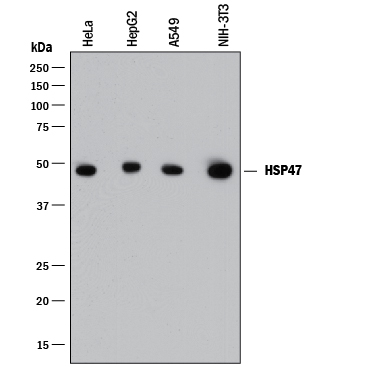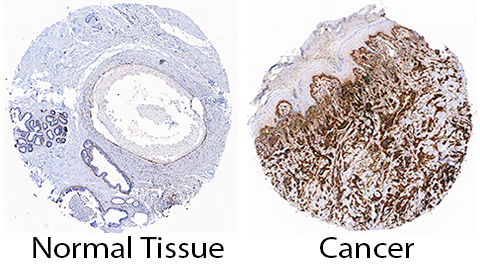Human/Mouse HSP47 Antibody Summary
Applications
Please Note: Optimal dilutions should be determined by each laboratory for each application. General Protocols are available in the Technical Information section on our website.
Scientific Data
 View Larger
View Larger
Detection of Human and Mouse HSP47 by Western Blot. Western blot shows lysates of HeLa human cervical epithelial carcinoma cell line, HepG2 human hepatocellular carcinoma cell line, A549 human lung carcinoma cell line, and NIH-3T3 mouse embryonic fibroblast cell line. PVDF membrane was probed with 0.1 µg/mL of Mouse Anti-Human/Mouse HSP47 Monoclonal Antibody (Catalog # MAB9166) followed by HRP-conjugated Anti-Mouse IgG Secondary Antibody (Catalog # HAF018). A specific band was detected for HSP47 at approximately 47 kDa (as indicated). This experiment was conducted under reducing conditions and using Immunoblot Buffer Group 1.
 View Larger
View Larger
HSP47 in Human Breast Cancer Tissue. HSP47 was detected in immersion fixed paraffin-embedded sections of human normal breast (left) and breast cancer tissue (right) using Mouse Anti-Human/Mouse HSP47 Monoclonal Antibody (Catalog # MAB9166) at 15 µg/mL overnight at 4 °C. Tissue was stained using the Anti-Mouse HRP-DAB Cell & Tissue Staining Kit (brown; Catalog # CTS002) and counterstained with hematoxylin (blue). Specific staining was localized to cancer cell cytoplasm. View our protocol for Chromogenic IHC Staining of Paraffin-embedded Tissue Sections.
Reconstitution Calculator
Preparation and Storage
- 12 months from date of receipt, -20 to -70 degreesC as supplied. 1 month, 2 to 8 degreesC under sterile conditions after reconstitution. 6 months, -20 to -70 degreesC under sterile conditions after reconstitution.
Background: HSP47
Heat Shock Protein 47 (HSP47), also known as Serpin-H1/CBP1/CBP2, is localized to endoplasmic reticulum (ER), where it is a collagen-specific molecular chaperone. In the ER, HSP47 interacts with and stabilizes correctly-folded procollagen. Nucleotide polymorphisms may be associated with preterm birth and Osteogenesis Imperfecta type X. Serpin-H1 is up-regulated in several cancers including squamous cell carcinoma, breast and prostate carcinomas. Expression in tumors drives malignant growth and invasion by enhancing deposition of extracellular matrix proteins.
- Christiansen HE, et al. (2010) Am. J. Hum. Genet. 86:3892.
- Tasab M, et al. (2000) EMBO J. 19:22043.
- Kwon YJ, et al. (2009) Oncol Res. 18:1414.
- Zhu J, et al. (2015) Cancer Res. 75:15805.
- Nese N, et al. (2010) Anal Quant Cytol Histol. 32:90.
Product Datasheets
Citations for Human/Mouse HSP47 Antibody
R&D Systems personnel manually curate a database that contains references using R&D Systems products. The data collected includes not only links to publications in PubMed, but also provides information about sample types, species, and experimental conditions.
2
Citations: Showing 1 - 2
Filter your results:
Filter by:
-
Targeting A-kinase anchoring protein 12 phosphorylation in hepatic stellate cells regulates liver injury and fibrosis in mouse models
Authors: Ramani K, Mavila N, Abeynayake A et al.
eLife
-
Crucial role of estrogen for the mammalian female in regulating semen coagulation and liquefaction in vivo
Authors: S Li, M Garcia, RL Gewiss, W Winuthayan
PLoS Genet., 2017-04-17;13(4):e1006743.
Species: Mouse
Sample Types: Tissue Homogenates
Applications: Western Blot
FAQs
No product specific FAQs exist for this product, however you may
View all Antibody FAQsReviews for Human/Mouse HSP47 Antibody
There are currently no reviews for this product. Be the first to review Human/Mouse HSP47 Antibody and earn rewards!
Have you used Human/Mouse HSP47 Antibody?
Submit a review and receive an Amazon gift card.
$25/€18/£15/$25CAN/¥75 Yuan/¥2500 Yen for a review with an image
$10/€7/£6/$10 CAD/¥70 Yuan/¥1110 Yen for a review without an image

